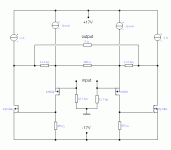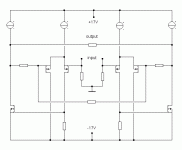I'm wondering if two Aleph output stages when put together could be used as a differential amplifier? Perhaps the active current sensing (feedback loop) won't allow for it and canncel out any gain/signal? If not maybe it would create a voltage doubling situation?
Any help appreciated.
Brett
Any help appreciated.
Brett
It'll work fine, in fact, an example will be used in a
future version of Son of Zen project. You can bias these
two where they join at the Sources of the bottom
transistors with a current source, or if you have a balanced
input signal, a resistor.
future version of Son of Zen project. You can bias these
two where they join at the Sources of the bottom
transistors with a current source, or if you have a balanced
input signal, a resistor.
I have to say, Nelson, these little hints of things to come at passdiy are sure enticing. I'm having trouble planning the project after the project after my next project.
Thanks for giving us some idea of what's coming up.
Thanks for giving us some idea of what's coming up.
Thanks Nelson.
More questions.
So if I am understanding things correctly a differential amplifer using the Aleph curcuit would be a very low distortion OPS for two reasons: 1. The noise cancelation inherent to a differential design which is (correct me if I'm wrong) the reduction of just random/floor noise by about 90%. 2. The reduced signal distortion beyond conventional constant current sources (as stated in the Aleph patent) which is due to (I think) the local (or is it negative?) feedback this type of active current sourse creates.
Brett
More questions.
So if I am understanding things correctly a differential amplifer using the Aleph curcuit would be a very low distortion OPS for two reasons: 1. The noise cancelation inherent to a differential design which is (correct me if I'm wrong) the reduction of just random/floor noise by about 90%. 2. The reduced signal distortion beyond conventional constant current sources (as stated in the Aleph patent) which is due to (I think) the local (or is it negative?) feedback this type of active current sourse creates.
Brett
Well here goes. This is my first post on this site.😱
Let me know if I'm mistaken, but this amp design sounds like an FET version of the A40 without the local feed back. Yes? No? Maybe?
Rodd
Let me know if I'm mistaken, but this amp design sounds like an FET version of the A40 without the local feed back. Yes? No? Maybe?
Rodd
Hi Rodd, What I am awkwardly talking about is a differential single-ended class A output stage like the SOZ but with the Aleph type constant current sources. The A40 I believe has a push-pull class A OPS. Push-pull and differential OPS types both offer noise reduction (symmetrical cancelation?) that is not inherent to a single-ended OPS.
Brett
Brett
The attached schematic may not be quite what you have in mind, but at least shows one approach along the lines you suggest. This example uses constant current sources rather than Aleph current sources, but I see no reason why you couldn't substitute the Alephs in there (assuming non-commercial use, of course).
I should also note that this design incorporates conventional balanced feedback rather than supersymmetry as used in the Pass X series. Also, as it has two stages, it is not a true Zen variation. In fact, you might think of it as a bridged pair of JLH 10W class A amplifiers done with MOSFETs. BTW, the values shown would give you about 35W rms into 8 ohms.
I can only offer this for your amusement as I've not actually built a working example. There may be a problem in practice with excessive DC offset drift, and you will certainly need to make either the input stage current sources or their drain load resistors adjustable so you can properly balance the output stage.
I should also note that this design incorporates conventional balanced feedback rather than supersymmetry as used in the Pass X series. Also, as it has two stages, it is not a true Zen variation. In fact, you might think of it as a bridged pair of JLH 10W class A amplifiers done with MOSFETs. BTW, the values shown would give you about 35W rms into 8 ohms.
I can only offer this for your amusement as I've not actually built a working example. There may be a problem in practice with excessive DC offset drift, and you will certainly need to make either the input stage current sources or their drain load resistors adjustable so you can properly balance the output stage.
Attachments
Thanks Joe, I haven't been able to find much out there for amps using a differential OPS, SOZ being the exception.
Certainly the schematic you posted is very close to what I would to eventualy like to build. I was just thinking of a Aleph amplifier modifyed with a differentail OPS. So yes two stages. I still trying to figure out what the best input stage/feeback configuration might be. Perhaps eliminating the global feedback altogether is a possibility.
Refering to your schematic the feedback from the final stage feeds into the Source pins instead of the gates. Why is this done? I think I might know why but I guess wrong to often.
Brett
Certainly the schematic you posted is very close to what I would to eventualy like to build. I was just thinking of a Aleph amplifier modifyed with a differentail OPS. So yes two stages. I still trying to figure out what the best input stage/feeback configuration might be. Perhaps eliminating the global feedback altogether is a possibility.
Refering to your schematic the feedback from the final stage feeds into the Source pins instead of the gates. Why is this done? I think I might know why but I guess wrong to often.
Brett
Joe,
It would be interesting if you built it. I wound suspect that you would need a servo to compensate for dc offset.
Jam
It would be interesting if you built it. I wound suspect that you would need a servo to compensate for dc offset.
Jam
How about this?
Okay, here's a more conventional take on the same basic idea that, as such, may be easier to follow. It is also not likely to suffer from offset drift problems. Again, we are dealing with a conventional bridging configuration, not an X type design.
My reason for omitting the input differential pairs from the first design is that a pair of diff pairs is -- well, at least rhetorically redundant, if not functionally so -- in a topology that is itself differential. (As the Zen aphorism has it, "the garden is finished when there is nothing left to remove.")
More to the point, although the diff pair is usually regarded as a single stage, it does add an extra time constant to the overall feedback loop, and for this reason IMO it should not be used indiscriminately. I'll admit that this probably is not a major issue in the context of a two-stage amplifier, but it can be a problem in more complex designs.
Okay, here's a more conventional take on the same basic idea that, as such, may be easier to follow. It is also not likely to suffer from offset drift problems. Again, we are dealing with a conventional bridging configuration, not an X type design.
My reason for omitting the input differential pairs from the first design is that a pair of diff pairs is -- well, at least rhetorically redundant, if not functionally so -- in a topology that is itself differential. (As the Zen aphorism has it, "the garden is finished when there is nothing left to remove.")
More to the point, although the diff pair is usually regarded as a single stage, it does add an extra time constant to the overall feedback loop, and for this reason IMO it should not be used indiscriminately. I'll admit that this probably is not a major issue in the context of a two-stage amplifier, but it can be a problem in more complex designs.
Attachments
In comparing the two circuits above, I should have noted that using a diff pair adds considerable gain to the circuit as well as another time constant. This extra gain can, in fact, be the bigger issue in stabilizing a multi-stage, closed-loop design.
Again, I don't mean to suggest that this is a big deal with the designs shown here -- only to note this difference which, in practice, might mean that you'd need to add a compensation scheme to the second circuit (as used in the Pass Aleph power amps), but not to the first.
Again, I don't mean to suggest that this is a big deal with the designs shown here -- only to note this difference which, in practice, might mean that you'd need to add a compensation scheme to the second circuit (as used in the Pass Aleph power amps), but not to the first.
- Status
- Not open for further replies.
- Home
- Amplifiers
- Pass Labs
- Aleph OPS as a differential amplifier. Possible?

